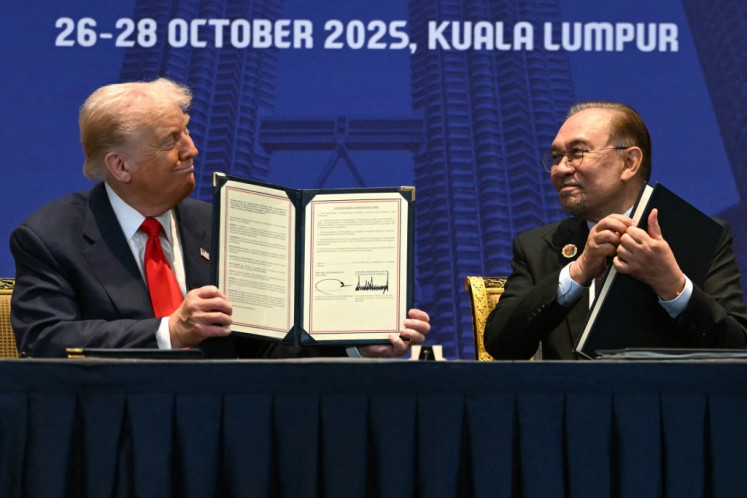Popular Reads
Top Results
Can't find what you're looking for?
View all search resultsPopular Reads
Top Results
Can't find what you're looking for?
View all search resultsYogyakarta offers volcanic tourism
Yogyakarta, the second-most visited tourist destination in Indonesia after Bali, now has a selection of geological and volcanic tour sites that visitors can enjoy
Change text size
Gift Premium Articles
to Anyone
Y
ogyakarta, the second-most visited tourist destination in Indonesia after Bali, now has a selection of geological and volcanic tour sites that visitors can enjoy.
By visiting the sites, visitors can witness the track of earthquake and volcanic activity over hundreds of millions of years.
“The latest location is the Kembangsongo Segment in Sindet hamlet, Bantul regency. In the rock quarry we can see a fault that records traces of earthquakes in the past,” Yogyakarta’s National Development University (UPN) geologist C. Prasetyadi told The Jakarta Post on Sunday.
The Kembangsongo Segment is located along the Opak Fault, which extends from Java’s south coast to Prambanan. The epicenter of earthquakes that have rocked Yogyakarta have usually been recorded along the Opak Fault.
“With the discovery of the Kembangsongo Segment of the fault, the Opak Fault, which is thought to be the epicenter of earthquakes in Yogyakarta, is not merely a discourse but a reality, as it can be seen and touched,” said Prasetyadi.
At the rock quarry site, fractures, in the form of lines extending along the vertical rock wall that separates the layers of rock, are visible on the left and right. These show the amplitude of quake vibrations breaking the layer.
Although it has often been broken, the fracture is then filled with mud from within the earth which hardens leaving a trail of line.
“I found this while conducting research on the Opak Fault in 2012 and 2013,” Prasetyadi said.
He said the fault along the Kembangsongo Segment became visible as a result of the rock quarrying activities, which displayed fresh rock formation and geological structures.
After Yogyakarta Governor Sultan Hamengkubowono inspected the location in May, the mining activities were stopped because the location could serve as an object of study for students majoring in geology.
A number of temples, such as Sambisari, Kedulan and Kimpulan, which were once buried, bear silent witness to the tremendous eruption of Mount Merapi thousands of years ago, during which massive emissions from the volcanic eruptions buried the temples.
Yogyakarta’s Science and Technology Academy geologist Sri Mulyaningsih said Mount Merapi had experienced at least six major eruptions from 92 to 954 CE, which buried the temples.
Tourists can also watch the torment caused by the incredible Mount Merapi eruption in 2010 by joining the lava tour in several villages, located on the southern slope, such as in Kinahrejo and Srunen villages.
Residents have initiated the building of a museum to record the impact of the eruption on the lives of the people.
The museum complements the Museum of Mount Merapi located in Kaliurang. The museum, called the Disaster Documentary Museum, occupies a house in the Dongkelsari residential complex in Srodokan hamlet, Sleman.
The museum, set up by Totok Hartanto, stores various items of household furniture belonging to residents who were buried by volcanic material. Video and audio recordings at the time of the disaster can also be accessed at this museum.
Many foreign tourists have begun visiting the simple museum.
“I opened this museum as a constant reminder to the local population. It can also be a place of learning for disaster mitigation,” said Totok.
A US geologist from Brigham Young University in Utah, Ron A. Harris, who attended a seminar during the 10th anniversary of the earthquake in Yogyakarta last May, said residents in densely-populated Java Island must be vigilant for earthquakes in the future.
The island, according to Harris, needs to have earthquake-resistant buildings to prevent the deaths of many people. “Based on history, in the future there will be more earthquakes in Java. We don’t know when but we know where,” he said.










